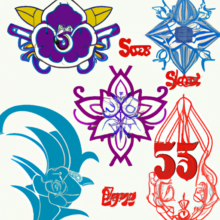The History of Tattoos
The History of Tattoos: A Journey Through Time and Cultures
Tattoos, a form of body art that has fascinated humanity for millennia, have evolved from ancient tribal practices to a global phenomenon. The history of tattoos is a rich and varied one, reflecting diverse cultural, spiritual, and artistic traditions. From their origins in ancient civilizations to their modern-day resurgence as a form of personal expression, tattoos have transcended social, political, and geographic boundaries, becoming a universal symbol of identity, status, and creativity.
Ancient Beginnings: The Origins of Tattoos
The history of tattoos stretches back thousands of years, with archaeological evidence showing that tattooing was practiced in many of the world’s oldest civilizations. One of the earliest known examples of tattooing comes from the discovery of Ötzi the Iceman, a mummy found in the Alps dating back to around 3300 BCE. His body was adorned with over 60 tattoos, primarily simple lines and crosses, which are believed to have had therapeutic purposes, potentially to relieve joint pain.
In ancient Egypt, tattoos were also common, particularly among women. Female mummies dating back to 2000 BCE have been discovered with elaborate designs on their bodies, suggesting that tattoos might have been associated with fertility, protection during childbirth, or other spiritual beliefs. The history of tattoos in Egypt is closely tied to their religious practices, with tattoos often serving as symbols of protection or devotion to specific gods and goddesses.
Across the globe in Polynesia, the history of tattoos took on an entirely different meaning. In Polynesian cultures, tattoos were not merely decorative but served as a rite of passage, a mark of status, and a symbol of one’s ancestry. The intricate, geometric designs used in traditional Polynesian tattooing were deeply significant, with each design telling the story of the wearer’s heritage, achievements, and social standing. Tattooing in these cultures was often a highly ritualized process, performed by skilled tattoo artists using sharpened bones or other tools to insert ink into the skin.
Tattoos in the Ancient World
The history of tattoos in the ancient world also includes the Greeks and Romans. While tattoos were less prevalent in these societies compared to others, they were still used for specific purposes. In ancient Greece, tattoos were often applied to slaves or prisoners of war as a form of identification, and in Rome, they were sometimes used to mark criminals or soldiers as a form of punishment or as a badge of honor. However, tattooing was not widely embraced by the elite in these societies, as it was seen as a practice for the lower classes.
In contrast, tattoos held great importance in Asian cultures, particularly in Japan. The history of tattoos in Japan is one of complex evolution. Initially, tattoos were used as a form of punishment, but over time, they developed into an art form known as irezumi. By the Edo period (1603–1868), full-body tattoos had become popular among certain groups, particularly members of the yakuza (the Japanese mafia), who used tattoos to display their loyalty and toughness. Japanese tattooing is known for its bold, colorful designs, often depicting dragons, koi fish, and other traditional symbols of strength, luck, and protection.
Tattoos in Religious and Cultural Contexts
The history of tattoos also intersects with religious beliefs. In Christianity, for example, tattoos were initially frowned upon due to interpretations of Biblical passages that seemed to forbid the practice. However, this view has changed over time, and today, many Christians use tattoos to express their faith through religious symbols or verses.
In other parts of the world, such as the Maori people of New Zealand, tattoos have always had a deep spiritual and cultural significance. Maori moko (facial tattoos) were a sacred rite of passage, with each individual’s moko being unique and reflective of their social status, achievements, and lineage. The process of receiving a moko was not only a physical but also a spiritual journey, one that connected the individual to their ancestors and the spiritual world.
The Modern Tattoo Renaissance
The modern era has seen a resurgence in the popularity of tattoos, driven in part by shifts in societal attitudes and advancements in tattooing technology. In the late 19th and early 20th centuries, tattoos were primarily associated with sailors, soldiers, and members of fringe subcultures. However, by the mid-20th century, they began to gain broader acceptance, particularly as tattoo artists began to refine their techniques and expand their artistic repertoires.
The history of tattoos in the 21st century reflects their growing mainstream acceptance, as people from all walks of life now embrace tattoos as a form of personal expression. Celebrities, athletes, and even politicians have helped to break down the stigma surrounding tattoos, making them more acceptable in professional and social settings.
The History of Tattoos Conclusion
The history of tattoos is a testament to the enduring human desire for self-expression, identity, and connection to culture and spirituality. From their ancient roots in therapeutic practices and tribal rituals to their modern-day role as a canvas for artistic expression, tattoos have remained a constant presence in human society, evolving with each new generation. As the art of tattooing continues to grow and adapt, it is clear that tattoos will remain a vibrant and meaningful part of human history for years to come.



